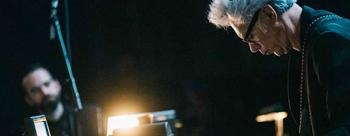by Nicholas Stevens

As that first remark hints, the word “dilettante,” like its cousin “amateur,” can be a compliment under the right circumstances — both words originated as descriptions of those who delight and love, but are not professionally committed to an art form. Jarmusch may not spend all or even much of his time on music, but the profound reverence for the form and its history that he professes in the second comment means that he takes music-making as seriously as filmmaking.
This devotion to sound as art would have been apparent had Jarmusch and Logan never spoken. Performing as SQÜRL, their live accompaniments for four short silent films by Man Ray buzzed and roared in a screening at CMA on Wednesday, November 1 in Gartner Auditorium. Not quite the “rock band” they claim to be, these two musicians rarely provide toe-tapping beats. It took a while for Jarmusch’s electric guitar, propped amid a nest of synthesizers and amplifiers, to even appear.
The duo’s soundtrack for the film L’Étoile de mer included few contributions from acoustic instruments at all. One of the challenges of drone-based music is immersing the audience in a mood while lending a narrative shape to their experience. Opening with oscillations over a foreboding bass note and broadening to include chilling chime-like sounds, SQÜRL’s music for this first film, a character sketch of a man obsessed with a starfish in a glass jar, created tension that changed but never resolved — much like the haunting, distorted visual track it commented on. In an inspired turn, Jarmusch allowed a long-held bass note to slide upward and downward without warning, a harmonic lurch that registered in the gut as much as in the ear.
The power of SQÜRL’s accompaniments depends on an audience’s tolerance for stasis, and by the beginning of the fourth film, Les Mystères du Château de Dé, their tactics had begun to wear thin. However, the duo introduced many unforgettable musical ideas over the course of the evening: the radiant guitar chords that greeted images of crashing waves in Emak Bakia, or the ecstatic arrivals, all quick to fade into uncertainty, laid over the pool scene of Les Mystères. The third film, Le Retour à la Raison, proved the most enigmatic and the least memorable. With visuals composed mainly of photograms — images created by placing objects directly on photosensitive paper — the film presents objects and human bodies spinning, and little else. Yet Les Mystères, a depiction of masked figures intruding into a sun-bathed castle, proved a haunting finale to this audiovisual symphony.
Published on ClevelandClassical.com November 6, 2017.
Click here for a printable copy of this article



